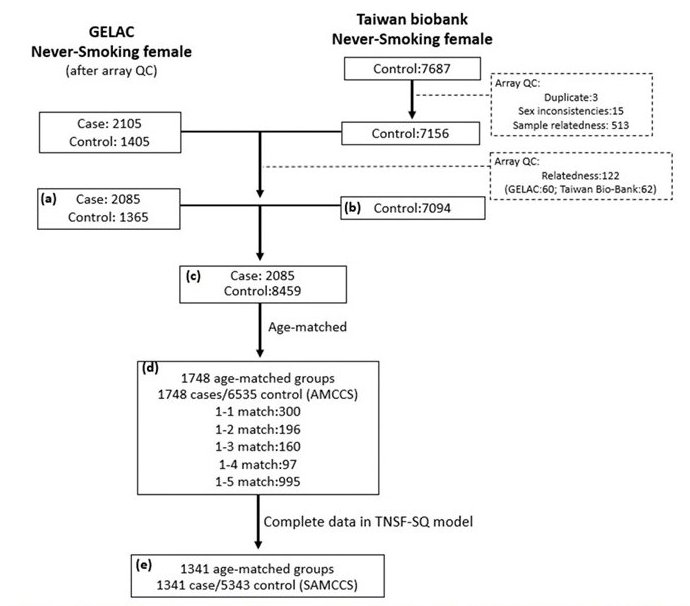Lung cancer in never-smokers (LCINS) ranks as the seventh most common cause of cancer-related death worldwide. The National Lung Screening Trial (NLST) showed screening for lung cancer using low-dose computed tomography (LDCT) reduced lung cancer mortality rate for 20% in high-risk individuals in the United States. The mortality reduction success depends critically on its application of screening to high-risk individuals. In the meantime, the proportion of LCINS has been increasing overtime, about 60%–80% of female patients with lung cancer in Asia are never-smoking females (NSFs), much higher than in the United States and Europe. In Taiwan, 55% of the lung cancers are in never-smokers, lung cancer is the leading cause of cancer-related death among women, and over 90% of female patients with lung cancer are never-smokers. Therefore, it is crucial to identify high-risk Asian NSFs who may benefit from LDCT screening.
Dr. Li-Hsin Chien and Dr. Chao A. Hsiung from the Institute of Population Sciences, together with Dr. I-Shou Chang from the National Institute of Cancer Research and collaborators utilized data on NSFs in the Taiwan Genetic Epidemiology Study of Lung Adenocarcinoma and the Taiwan Biobank before August 2016 to form an age-matched case–control study consisting of 1,748 patients with lung cancer and 6,535 controls. Using these and an estimated age-specific lung cancer 6-year incidence rate among Taiwanese NSFs, the team developed the Taiwanese NSF Lung Cancer Risk Models using genetic information and simplified questionnaire (TNSF-SQ). Performance evaluation was based on the newer independent datasets: Taiwan Lung Cancer Pharmacogenomics Study (LCPG) and Taiwan Biobank data after August 2016 (TWB2).

The AUC based on the NSFs ages 55 to 70 years in LCPG and TWB2 was 0.714 [95% confidence intervals (CI), 0.660–0.768]. For women in TWB2 ages 55 to 70 years, 3.94% (95% CI, 2.95–5.13) had risk higher than 0.0151. For women in LCPG ages 55 to 74 years, 27.03% (95% CI, 19.04–36.28) had risk higher than 0.0151. These findings demonstrated the good discriminative power of TNSF-SQ. Compared with the USPSTF screening criteria for heavy smokers in the US, its ability to identify 27.03% of high-risk Asian NSFs ages 55 to 74 years deserves attention, suggesting its potential use in selecting Asian NSFs for LDCT screening.
Citation: Chien, LH; Chen, CH ; Chen, TY; Chang, GC; Tsai, YH; Hsiao, CF; Chen, KY; Su, WC; Wang, WC ; Huang, MS; Chen, YM; Chen, CY; Liang, SK; Chen, CY; Wang, CL; Lee, MH; Chung, RH; Tsai, FY; Hu, JW; Katki, HA; Chatterjee, N; Chanock, SJ; Rothman, N; Lan, Q; Yang, PC ; Chen, CJ; Chang, IS; Hsiung, CA. Predicting lung cancer occurrence in never-smoking females in Asia: TNSF-SQ, a prediction model. Cancer Epidemiology, Biomarkers and Prevention. 2020 Feb;29(2):452-459.
